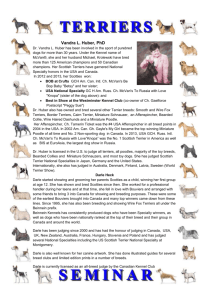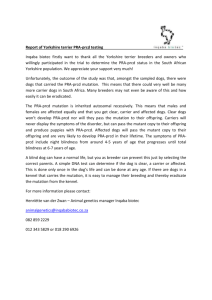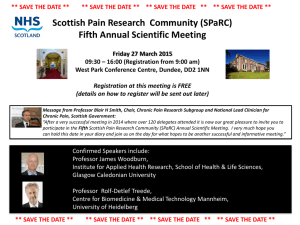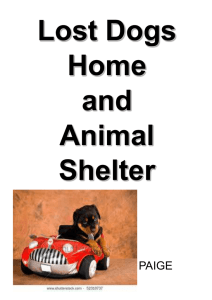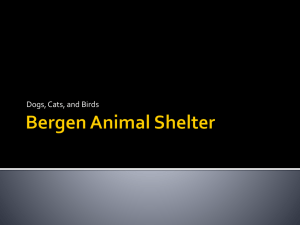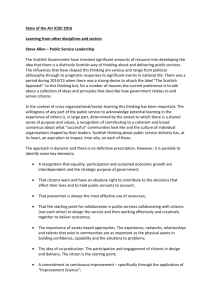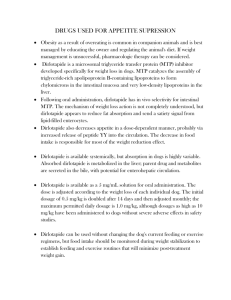Instructions for completing the STCA HTF 2015 Survey/Census
advertisement
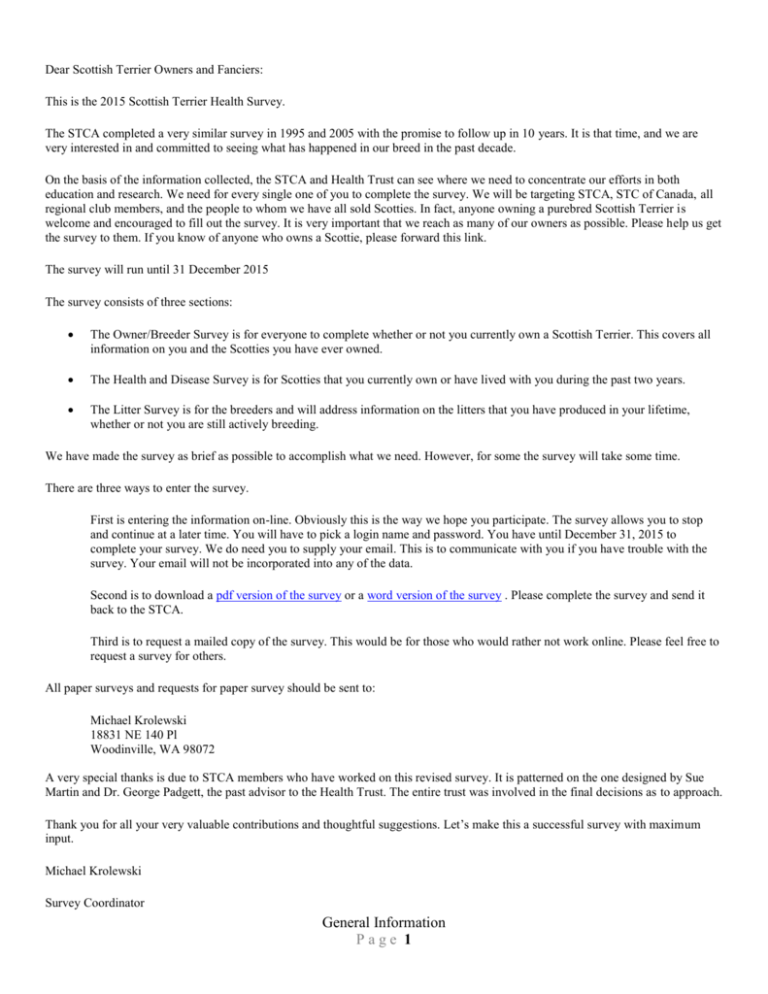
Dear Scottish Terrier Owners and Fanciers: This is the 2015 Scottish Terrier Health Survey. The STCA completed a very similar survey in 1995 and 2005 with the promise to follow up in 10 years. It is that time, and we are very interested in and committed to seeing what has happened in our breed in the past decade. On the basis of the information collected, the STCA and Health Trust can see where we need to concentrate our efforts in both education and research. We need for every single one of you to complete the survey. We will be targeting STCA, STC of Canada, all regional club members, and the people to whom we have all sold Scotties. In fact, anyone owning a purebred Scottish Terrier is welcome and encouraged to fill out the survey. It is very important that we reach as many of our owners as possible. Please help us get the survey to them. If you know of anyone who owns a Scottie, please forward this link. The survey will run until 31 December 2015 The survey consists of three sections: The Owner/Breeder Survey is for everyone to complete whether or not you currently own a Scottish Terrier. This covers all information on you and the Scotties you have ever owned. The Health and Disease Survey is for Scotties that you currently own or have lived with you during the past two years. The Litter Survey is for the breeders and will address information on the litters that you have produced in your lifetime, whether or not you are still actively breeding. We have made the survey as brief as possible to accomplish what we need. However, for some the survey will take some time. There are three ways to enter the survey. First is entering the information on-line. Obviously this is the way we hope you participate. The survey allows you to stop and continue at a later time. You will have to pick a login name and password. You have until December 31, 2015 to complete your survey. We do need you to supply your email. This is to communicate with you if you have trouble with the survey. Your email will not be incorporated into any of the data. Second is to download a pdf version of the survey or a word version of the survey . Please complete the survey and send it back to the STCA. Third is to request a mailed copy of the survey. This would be for those who would rather not work online. Please feel free to request a survey for others. All paper surveys and requests for paper survey should be sent to: Michael Krolewski 18831 NE 140 Pl Woodinville, WA 98072 A very special thanks is due to STCA members who have worked on this revised survey. It is patterned on the one designed by Sue Martin and Dr. George Padgett, the past advisor to the Health Trust. The entire trust was involved in the final decisions as to approach. Thank you for all your very valuable contributions and thoughtful suggestions. Let’s make this a successful survey with maximum input. Michael Krolewski Survey Coordinator General Information Page 1 Instructions for completing the STCA HTF 2015 Survey/Census The survey should be completed and returned to the address on the introduction by December 31, 2015. Obviously you may return it at any time. If you would like a conformation that the survey was received, include a separate page with that request. Include your name and contact information. This will be separated from your survey. There are three sections to the survey. They are identified by the footer on each page. The first section is General Information. Everyone should complete this section. When referring to your dogs, only respond about dogs that you own or co-own that resided at your home on 1 August 2015. Include any dogs that were away temporarily eg at a dog show, being breed, temporarily boarded at the vet or someone else’s home on the1 August 2015. Do not include co-owned dogs that reside with the coowner. Do not include dogs that are temporarily visiting your home. The second section is Health and Disease Survey. This section need be filled out only if you owned or co-owned purebred Scottish Terrier which resided at your residence on 1 August 2015 AND/OR for any owned or co-owned purebred Scottish Terrier that resided at your home that died between 1 August 2013 and 1 August 2015. Same rules apply as you used in the General Information section. If you have more dogs then what fits on the single page, feel free to make a copy of this page. The third section is the Reproduction Information. If you have never bred a purebred Scottish Terrier, please skip this section. If you are no longer breeding, fill in the first part of this section up to the list of breedings. If you are currently breeding, please fill in the litter that you produced or attempted to produce. If you need more space, copy and add additional pages. The breeding window spans from 1-August 2013 to 1 August 2015. As with the other sections, you are responding about the purebred Scottish Terriers that you owned or co-owned that resided at your house. If you whelped a bitch for someone else, that should not be included by you. If your bitch was whelped by someone else, include that in your litter information. Thanks for supporting the STCA by completing this survey. Your information is valuable to the club and its membership. General Information Page i Scottish Terrier Club Of America Owner/Breeder Survey This section of general information includes questions for all purebred Scotties that you own or have owned. Please complete this form even if you do not currently own a Scottie but have in the past. Circle Y or N to answer yes and no questions. General Information - Environment 1. What is your country of residence: USA Canada Mexico Other _______________________ 2. What region do you live in: Northeast Region (ME, VT, NY, NH, MA, RI, CT, Quebec, New Brunswick, Maritime provinces) Mid-Atlantic (PA, NJ, DE, MD, VA, DC) Mid-South (WV, KY, TN, NC, SC) Southeast (MS, AL, GA, FL) Great Lakes (WI, IL, MI, IN, OH, Ontario) North Central (NE, IA, SD, ND, MN, MT, Saskatchewan, Manitoba) South Central (KS, MO, OK, AR, TX, LA) Northwest (AK, WA, OR, ID, MT, British Columbia, Alberta) Pacific (CA, NV, HI) Rocky Mountain (AZ, CO, NM, UT, WY) International (other than Canada) 3. Would you describe the area you live in as Urban/Major Metropolitan Area Suburban Rural/Small Town Farm 4. How many years have you been at this residence? ____ 5. How big is the nearest city to you: < 10,000 people 10,000 – 60,000 60,000 – 100,000 > 100,000 6. How much land is associated with your residence: No land ¼ Acre ½ Acre 1 Acre Up to 5 Acres More than 5 Acres General Information Page 1 7. What best describes the source of your dog’s drinking water supply? Municipal/city water Well Bottle Water Artesian/Spring feed Other 8. What water treatments are applied to your dogs’ drinking water supply? Check all that apply: Chlorinated Fluoridated Filtered Softened Reverse Osmosis Distilled None 9. Does your dog have access to grass for urinating and defecating? Y/N If yes, mark all that apply to your situation: Fenced yard (any type of fencing) Free access with doggie door into fenced yard Restricted access, and let outside several times a day. Restricted access, and let out morning and evening after work. No fence, dogs are walked for exercise in parks, sidewalks, etc. No fence, dogs are tied out. If no access to grass, mark all that apply to your home situation: Outdoor kennel on concrete or other similar material Outdoor open area on concrete or similar material Indoor kennels only 10. Do you use fertilizers in your yard? Y/N 11. Do you use herbicides in your yard? Y/N If yes, how often is your yard treated? RarelyFertilizers____Herbicides_____ Once a yearFertilizers____Herbicides_____ Twice a yearFertilizers____Herbicides_____ Monthly, using a lawn serviceFertilizers____Herbicides___ 12. Does your dog have access to the treated areas in your yard? Y/N General Information- Scottie and Owner Activities 1. Are you or any household members employed in the following businesses? (Check all that apply) Veterinary or veterinary related employment Groomer Dog/Animal Boarding/Kennel Professional Handler Farming or animal husbandry 2. Are you currently a member of the Scottish Terrier Club of America (STCA)? (Y/N) 3. Are you currently a member of any other National Scottish Terrier Clubs? (Y/N) 4. Are you currently a member of a regional Scottish Terrier club? (Y/N) General Information Page 2 5. How many members of your household actively participate with your Scottish Terriers? Number of Adults between 18 and 30 Number between 30 and 50 50 and older Number under 18 6. Mark the number of household members who participate in the following activities:| Never Rarely Occasionally Regularly Companionship Conformation Youth activities e.g. Junior Showmanship, 4H Breeding Program Obedience Agility Earthdog Rally Tracking Therapy Dog Barn Hunting 7. How many animals do you currently own? (All animals that you own or co-own including puppies that would normally be housed at your house including dogs that are at vet or travelling): Purebred Scottie Dogs (12 months and older) Purebred Scottie Bitches (12 months and older) Purebred Scottie Dogs Neutered (12 months and older) Purebred Scottie Bitches Spayed (12 months and older) Purebred puppies (under 12 months) Non-purebred Scotties Other purebred dogs/bitches Other non-purebred dogs/bitches 8. How many Scotties have you owned or co-owned over the past 10 years? ( Include all animals that you have or currently own or co-own that would have been housed at your residence including the current animals. Exclude puppies that you produced and had placed or intend to place): Purebred Scottie Dogs (in tact or neutered) Purebred Scottie Bitches (in tact or spayed) Non-purebred Scotties 9. In the last 10 years how many of your own Scotties did you enter in AKC events? Attempted title Conformation title Single obedience title Two or more obedience titles Agility title Earthdog Other titles, e.g. Barn Hunt General Information Page 3 Received a title 10. Please mark the correct response: Compared to 10 years ago, I currently have _____ Scottish Terriers Many more More About the same Fewer Considerably fewer No 11. Please mark the correct response: In the 5 years from now, I will have _______ Scottish Terriers compared to today. many more more about the same fewer considerably fewer One or two No General Information - Health and Care 1. What is the average life span of all the Scotties that you have owned? Oldest? 2. Do you use a heartworm preventative? Y/N If YES, how often applied? Brand name? Do you use this heartworm preventative in your breeding stock? Y/N Bitches in whelp (Y/N)? Stud dogs (Y/N)? 3. Do you use flea and tick preventive? Y/N If YES, What is the Brand name? How often applied?_________ What type of flea/tick product do you use? Spot-on spray shampoo powders collar pill Do you use this product in breeding stock? (Y/N) Do you use this product on your bitches in whelp? (Y/N) Do you use this product on your stud dogs? (Y/N) General Information Page 4 The Canine Health Information Center, also known as CHIC, is a centralized canine health database sponsored by the Orthopedic Foundation for Animals (OFA). Working with participating parent clubs, CHIC provides a resource for breeders and owners of purebred dogs to research and maintain information on the health issues prevalent in specific breeds by establishing a recommended protocol for health screening and recognizing dogs tested in accordance with that protocol. 4. Are you currently working on CHIC certification for your dogs? (Y/N) If yes, which Scotties? None Only stud dogs and brood bitches Only bitches Only studs All dogs that I produced All dogs that I keep All 5. How many Scotties that you currently own or have owned at any time have earned a CHIC number?_______ 6. How many Scotties that you currently own do you expect to complete their CHIC testing in the next year?________ 7. If you are a breeder, what vaccination schedule do you follow for your puppies? (Fill in the blanks where indicated) The pups receive their first DHPP* Core vaccine at ____weeks, and then receive boosters every ___ weeks until ___ of age. [*Distemper, Hepatitis, Parainfluenza, Parvovirus] One more DHPP vaccine is given one year after last puppy shot. Y/N Is Coronavirus is included in the puppy vaccine? Y/N Is Leptospirosis is included in the puppy vaccine? Y/N Rabies vaccine is given at _____months of age. Bordatella (Kennel Cough) is given at _____week of age. 8. How often are your adult Scotties vaccinated? Yearly Every three years No vaccines after the puppy series Titers only 9. Which vaccines are used for your adults? (Check all that apply) DHPP Leptospirosis Lyme Rabies Bordatella (Kennel Cough) Other ______________________ 10. Which of the following best fits the category of food you give to your Scotties? (Check all that apply) Commercial dry kibble Commercial canned food Prescription diet from Veterinarian Home prepared treats, veggies, fruits, etc. Home cooked diet- exclusive Home prepared raw diet Commercial raw diet General Information Page 5 11. What are the major health concerns in your Scotties? 1 2 3 12. What do you consider the three most serious problems in the Scottish Terrier breed? 1 2 3 General Information Page 6 Scottish Terrier Club Of America Health And Disease Survey Complete a line for each purebred Scottish Terrier either owned on August 1, 2015 or owned and died between August 1, 2013 and August 1, 2015. Add additional pages as needed to cover all dogs Complete a line even if the purebred Scottish Terrier has no health problems Dog# Sample A 1 Age Year Month 4 yr 5 m Sex F F/sp M M/neut F/sp Date Spayed or Neutered or N/A Registered: AKC UKC Or N/A Color Black Brindle Wheaten Date Died Or N/A List All Diseases Or Health Problems Affecting This Dog (See Health Problem List) Current Status ((See Key At Bottom Of Page) Approximate Age At Onset Of Disorder Diagnosed By: Regular Vet, Specialist, Lab Test Owner 10 months AKC Black N/A Undershot Hypothyroid N N 6 month 1 ½ yr Owner/Vet Vet/Lab Test 2 3 4 For any litters born between August 1, 2013 and August 1, 2015, complete a litter survey form Current Status: N – Normal activity &/or lifestyle NT – Normal activity &/or lifestyle with treatment R -- Mild restrictions or interference in lifestyle or activity RT -- Mild restrictions or interference in lifestyle or activity with treatment S -- Severe restrictions or interference in lifestyle or activity ST – Severe restrictions or interference in lifestyle with treatment D – Died or euthanized as result of the problem O – Died or euthanized – not related to any problem General Health Survey Page1 Reproductive Information This section should be filled out by anyone that breeds or has bred Scottish Terriers in the past. 1. How many litters have you ever bred? 2. In the last 10 years a. How many litters have you bred? b. How many breedings did not take? c. How many Caesarian sections did you do? d. Total number of i. surviving puppies ii. stillborn pups iii. fading pups iv. resorbed pups e. What is your average litter size at birth (include surviving and non-surviving puppies)? f. Largest Litter size g. Smallest Litter size h. How many bitches experienced i. Uterine inertia ii. Eclampsia iii. Mastitis iv. Pyometritis i. Have you had bitches with i. Erratic seasons ii. Silent seasons 3. How many stud dogs (intact males that you might breed) do you currently own? 4. Do you collect and store semen of your stud dogs? (%) 5. How many brood bitches (intact females that you might breed) do you currently own? 6. At what age do you normally breed a bitch for the first time? ( year/month) a. Last time? (year/month) b. At what age do your bitches normally come into season (month) i. Earliest ii. Latest iii. Average frequency of seasons 7. Do you assist your bitches during whelp (Y/N) 8. Do you spay bitches when they will no long be bred? (Y/N) 9. Do you neuter males when the will no long be at stud? (Y/N) 10. Do you check litter size prior to birth a. X-ray ( % of litters) b. Ultra Sound ( % of litters) Reproduction Survey Page1 11. Do you do any testing prior to breeding (check all that apply) a. Never test b. Have stud dog fertility check c. Progesterone to assess time of ovulation d. Vaginal Cytology to assess onset of estrus e. Vaginal infections f. Brucellosis Bitches_Y/N g. Brucellosis Stud dogs Y/N h. Other 12. What method(s) do you use for the majority of your breedings? a. Natural Cover b. AI c. Chilled Semen d. Surgical Implant Reproduction Survey Page2 Scottish Terrier Club Of America Litter Survey Complete a line for each purebred Scottish Terrier litter born in your kennel or home that you owned or co-owned between August 1, 2013 and August 1, 2015. Include lines even if the breeding did not take. Litter Date Of Birth Sample A 1/14/2015 Sample B None born Number of Pups # Males # Females Color 2 males 2 females 2 wheatens 3 black Number with disease or birth defects noted prior to 12 weeks of age Fertilization Method: (see Sheet) Delivery Method: (see Sheet) Number Still Born Number Died Between Birth and 12 Weeks of Age Cause, if known None 1 Never concieved 1 2 3 Reproduction Survey Page1 1 fading puppy syndrome Disease List BEHAVIOR Aggression(g) Fearfulness Instability (Erratic, Unpredictable) BIRTH DEFECTS/ NEONATAL DISORDERS Cleft Palate/Lip Open Fontanelle Hydrocephalus Anasarca (Water Baby)(g) Joint Or Limb Deformity Anorectal Defects(g) Shistosomus Reflexus(g) Fetal Resorption Still Born Puppies Fading Puppies Swimmer Flat Chest BLOOD DISORDER Von Willebrand’s Disease (Vwd) (g) Factor IX Hemophilia B (Christmas Disease) (g) Thrombopathia(g) Polycythemia(g) ENDOCRINE Hypothyroidism(g) Hyperthyrodism Addisons Disease Cushings Disease Pancreatitis Diabetes Mellitus EYE Eyelid/Eyelash Problems Frequent Eye Infections Lens Luxation(g) Glaucoma Cataracts(g) Progressive Retinal Atrophy (PRA) (g) Blocked Nasolacrimal (Tear) Ducts Corneal Dystrophy (Fatty Deposits On Cornea) Iris Freckling/ Iris Pigment Remnant Persistent Papillary Membrane(PPM) (g) Sudden Onset Iritis (SARDS) (g) GASTROINTESTINAL SYSTEM Pica(g) Megaesophagus(G) Gastritis (Chronic) Inflammatory Bowel Disease Colitis (Chronic) Intestinal Blockage Requiring Surgery Exocrine Pancreatic Disease (Epi, Etc) (g) HEARING AND BALANCE Aural Hematomas(g) Ear Infections (Chronic) Deafness (Specify If Born Deaf Or With Age) Vestibular Disease ( Inner Ear Disease) (g) CANCER BLOOD AND LYMPHATIC SYSTEM Lymphosarcoma Leukemia Myeloma BONE Osteosarcoma Fibrosarcoma Chondrosarcoma GASTROINTESTINAL TUMOR Lymphosarcoma Hemangiosarcoma Carcinoma MAMMARY TUMOR Adenocarcinoma Adenoma NASAL CAVITY Carcinoma Sarcoma ORAL CAVITY Melanoma Squamous Cell Carcinoma Fibrosarcoma Epulis(g) SKIN Mast Cell Tumor Melanoma T-Cell Lymphoma Histiocytoma (Benign) Lipoma/Liposarcoma SPLEEN Hemangiosarcoma Hemangioma URINARY TRACT TCC Of Bladder, Urethra Kidney Carcinoma OTHER TUMORS – HEART Pulmonary Stenosis(g) Subaortic Stenosis (SAS) (g) Patent Ductus Arterosis (PDA) (g) Ventricular Septal Defect (VSD) (g) Vascular Ring Anomaly(g) Cardiomyopathy(g) Congestive Heart Disease IMMUNE SYSTEM Immune Mediated Hemolytic Anemia(g) Immune Mediated Thrombocytopenia(g) Systemic Lupus Erythematosis (Sle) (g) Rheumatoid Arthritis(g) Polyarthritis(g) Erythema Multiforme(g) Pemphigus Complex(g) Myositis(g) Vaccine Reaction / Failure Drug Reaction Anaphylaxis Stomatitis Demodectic Mange INFECTIOUS DISEASE Systemic Infections (Viral, Bacterial, Fungal, Etc) Parasitic Infections Protozoal - Coccidia, Ciardia, Neospora Worms – Round, Whip, Hook, Tape Disease List Ectoparasite – Sarcoptes, Cheyletiella Ear Mites (Chronic Infestation) Fleas (Chronic Infestation) Heartworm LIVER Copper Toxicosis (Confirmed) (g) Chronic Active Hepatitis(g) Elevated Liver Enzymes (Idiopathic) (g) Protosystemic Shunt Liver Failure Gall Bladder Disease NEUROLOGICAL SYSTEM Scottie Cramp Seizure Disorders ( Epilepsy, Etc) Cerebellar Abiotrophy Spinal Cord/Disk Disease Vertebral Malformation Myasthenia Gravis(g) Tremors NOSE OR ORAL CAVITY Sinusitis / Rhinits (Chronic) Nosebleeds (Chronic) Gingivitis Stomatitis Periodontal Disease With Tooth Loss Failure Of Eruption Of Adult Teeth Overshot / Undershot Bite/Wry Mouth Tonsillitis RESPIRATORY SYSTEM Chronic Cough Pneumonia ( Bacterial, Viral, Fungal ) Allergy ( COPD, Asthma, Etc) Lung Parasite ( Fluke, Etc) REPRODUCTION SYSTEM Pyometriis Cystic Ovaries Poor Libido / Low Sperm Counts Hypogonadism Prostatic Disease (BPH, Abscess, Cysts, Etc) Cryptorchidism Monorchidism SKELETAL (BONE AND JOINT) Kinked Tails Hip Dysplasia(g) Legg-Calve-Perthes Disease(g) Elbow Dysplasia(g) Arthritis Patellar Luxation(g) Cruciate Ligament Rupture Achondroplasia(g) Craniomandibular Osteopathy (Cmo) (g) Osteochondritis Dissecans (Ocd) (g) SKIN Pruritis(g) Hot Spots (Significant Or Recurring) Atopic Dermatitis (g) Primary Seborrhea (g) Demodectic Mange Sebaceous Adenitis(g) Sebaceous Cysts Cyclic Follicular Dysplasia(g) TISSUE DEFORMITIES Hernia – umbilical Hernia – inguinal Hernia - scrotal TRAUMA ( ACCIDENTS, TOXICITY, POISONS ) OBESITY URINARY SYSTEM Cystinuria(g) Urolithiasis (Bladder, Kidney Stones) (g) Cystitis (Chronic Infection Of Bladder) Disease List BEHAVIOR Aggression- Excessively assertive or forceful with Other dogs and/or people. May attack or bite without reasonable provocation. Unpredictable. BIRTH DEFECTS/NEONATAL DISORDERS Anasarca- "Water Baby". Defect in lymphatic system formation resulting in excessive fluid accumulation in all parts of the body. Anorectal defects- Missing or malformed anus or rectum resulting in inability to defecate normally. Shistosomus reflexus- Deviation of spinal cord accompanied by abnormal body wall formation with thoracic and/or abdominal contents being exposed at birth. BLOOD DISORDERS Hemophilia B- Christmas Disease; Absence of Factor IX of the clotting system leading to potentially excessive and fatal hemorrhage. Von Willebrand's Disease- Reduced Factor VIII resulting in prolonged bleeding time; may be mild or severe and can cause death. Thrombopathia- Abnormality of platelets resulting in clotting problems and bleeding. Polycythemia- Abnormally high numbers of circulating red blood cells, either primary disorder or secondary to other diseases. ENDOCRINE Hypothyroidism- Destruction of the thyroid gland due to an attack from animal's own immune system; causes skin problems, hair loss, lethargy, weight gain, poor reproductive performance. EYE Cataract- Lens opacity which can obscure vision; may be juvenile or adult onset Lens Luxation- Dislocation of the lens from its normal site; may be partial or complete; can contribute to the development of glaucoma. Progressive Retinal Atrophy- Degeneration of the retinal vision cells which leads to blindness. Persistent Pupillary Membrane- Failure of fetal pupillary membrane to atrophy causing strands to extend across the anterior chamber. SARDS- Sudden acquired retinal degeneration GASTROINTESTINAL Pica- Craving for substances not ordinarily considered as food. Megaesophagus- Enlarged, flaccid esophagus characterized by regurgitation. May be congenital, inherited, or secondary to other disease processes. Exocrine Pancreatic Insufficiency - Disorder of the pancreas resulting in deficiency of digestive enzymes; characterized by chronically loose stools, weight loss and voracious appetite. EAR Aural Hematoma- Accumulation of blood between the cartilage and skin of the ear flap. Usually due to ear infection with head shaking. Vestibular Disease- Infection or lesion in inner ear or brain causing head tilt, incoordination, abnormal eye movement, salivation and vomiting. HEART Pulmonic Stenosis-Congenital narrowing of the right ventricular outflow tract to the lungs. Subaortic Stenosis (SAS)- Congenital narrowing of or near the valve at the left ventricular outflow tract. Patent Ductus Arteriosis (PDA)- Failure of a fetal vessel to close at birth, resulting in blood bypassing the lungs. Ventricular Septal Defect (VSD)- Congenital defect resulting in a hole in the wall between the two ventricles. Vascular Ring Anomaly- Defect in formation of the great vessels of the heart, resulting in compression of the esophagus, regurgitation and megaesophagus in the weaned puppy. Cardiomyopathy- Enlargement of the heart; may be either dilated, thin walled chambers or thickened walls with reduced chamber size; leads to cardiovascular compromise and heart failure. Congestive Heart Disease- Any disease process leading to inability of heart to pump blood effectively, resulting in fluid build up in lungs and heart failure. LIVER Copper Toxicosis- Chronic inflammation of the liver caused by inability to excrete or remove excess copper from liver cells. May be slowly progressive or rapidly fatal. Chronic Active Hepatitis- Long standing, active inflammation of the liver, due to many different causes, usually progressing to end Disease List stage liver disease (cirrhosis). Elevated Liver Enzymes- Documented, unexplained elevations of enzymes (ALP in particular) with no other clinical signs or disease diagnosed. NEUROLOGICAL SYSTEM Myasthenia Gravis- Disorder of neuromuscular transmission characterized by muscular weakness that worsens with exercise. Maybe be congenital, inherited, or acquired. IMMUNE SYSTEM Immune Mediated Hemolytic Anemia- Life threatening destruction of red blood cells by immune system Immune Mediated Thrombocytopenia- Immune system destruction of platelets, compromising the ability to clot. Systemic Lupus Erythematosis- Chronic immune attack on many organs in the body, including skin, joints, kidney. Rheumatoid Arthritis- Rare disease that results in progressive joint destruction with variable age of onset. Polyarthritis- Immune mediated arthritis affecting multiple joints with fever, lameness and generalized pain. Pemphigus Complex-A group of uncommon autoimmune skin disease characterized by mild to severe blistering, ulceration and other lesions in the skin and mucous membranes. Erythema Multiforme- Uncommon, acute usually self limiting eruption of the skin and/or mucous membranes in distinctive red target lesions. May be severe. Myositis- Immune inflammatory process of skeletal muscles which results in pain, stiff-stilted gait, muscle weakness, swelling and/or atrophy. Stomatitis- Inflammation of the soft tissues of the oral cavity resulting in pain, ulcers, drooling, periodontal disease, tooth loss. May be the result of systemic, metabolic disease or immune attack on oral tissues. Demodectic Mange- Inflammatory skin disease caused by proliferation of mites normally present in low numbers, leading to deep skin infection and hair loss. May be localized or generalized. In adult dog, usually is result of compromised immune system. SKELETAL Hip Dysplasia- Inherited defect characterized by abnormal formation of the hip socket resulting in progressive lameness, pain and arthritis. Legg-Calve-Perthes- Asceptic necrosis of the femoral neck and head, causing lameness. Elbow Dysplasia- Abnormal development of the elbow joint, leading to instability of the joint, pain, arthritis, and lameness. Patellar Luxation- Poor development of the structures holding the knee cap in place, resulting in luxation usually medially (inward). Achondroplasia- Lack of normal development of the skeleton, resulting in dwarfism. Craniomandibular Osteopathy (CMO)- Painful inflammatory disease of bone in young dog, usually in jaw, on head or extremities, resulting in abnormal excess bony growth. Osteochondritis Dissecans- Aseptic necrosis of bone under joint cartilage, resulting in lameness. SKIN Pruritis- Significant itching, chewing, licking, usually due to allergies, food sensitivities, parasites (fleas), or contact with chemicals. May be seasonal or year round. Atopic Dermatitis- Inherited allergic skin disorder due to inhaled or contact with pollen, molds or other allergens. Skin may become rough, red, hairless, secondarily infected. May be seasonal or year round. Primary Seborrhea- Greasy, odoriferous coat with heavy flaking of skin. May be a result of endocrine disorder, ex hypothyroidism. Sebaceous Adenitis- Inflammatory disease directed against the sebaceous glands in the skin. May be inherited, immune mediated or metabolic. Leads to dull brittle hair coat, hair loss, excessive scale, secondary bacterial infections. Cyclic Follicular Dysplasia- Temporary pattern hair loss mostly over the trunk and flanks, may be seasonal, aka "seasonal flank alopecia". URINARY SYSTEM Cystinuria- Defective renal transport of the amino acid cystine and other amino acids, which can predispose to cystine crystal and stone formation in the kidneys and bladder. Urolithiasis- Formation of mineral concretions (stones) in the bladder and/or kidney. Stones may be made of a variety of materials and are due to a variety of causes- inherited, metabolic, and infectious.

